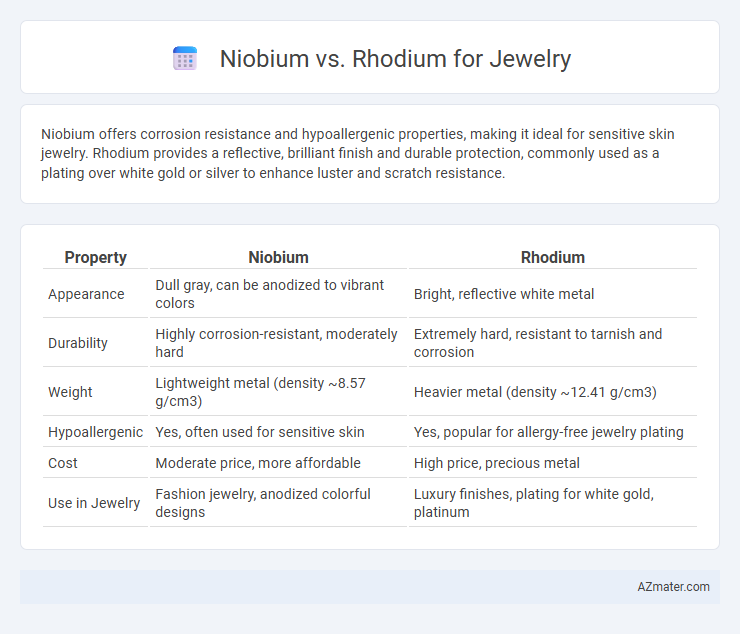Niobium offers corrosion resistance and hypoallergenic properties, making it ideal for sensitive skin jewelry. Rhodium provides a reflective, brilliant finish and durable protection, commonly used as a plating over white gold or silver to enhance luster and scratch resistance.
Table of Comparison
| Property | Niobium | Rhodium |
|---|---|---|
| Appearance | Dull gray, can be anodized to vibrant colors | Bright, reflective white metal |
| Durability | Highly corrosion-resistant, moderately hard | Extremely hard, resistant to tarnish and corrosion |
| Weight | Lightweight metal (density ~8.57 g/cm3) | Heavier metal (density ~12.41 g/cm3) |
| Hypoallergenic | Yes, often used for sensitive skin | Yes, popular for allergy-free jewelry plating |
| Cost | Moderate price, more affordable | High price, precious metal |
| Use in Jewelry | Fashion jewelry, anodized colorful designs | Luxury finishes, plating for white gold, platinum |
Introduction to Niobium and Rhodium in Jewelry
Niobium and rhodium are both popular metals used in jewelry for their unique properties and aesthetic appeal. Niobium is prized for its hypoallergenic qualities and ability to be anodized into a variety of vibrant colors, making it ideal for those with sensitive skin and modern designs. Rhodium, a rare and durable precious metal, is often used as a plating to enhance the shine and scratch resistance of white gold and silver jewelry.
Physical Properties: Niobium vs Rhodium
Niobium exhibits a lower density of approximately 8.57 g/cm3 compared to rhodium's denser 12.41 g/cm3, making niobium lighter and more comfortable for jewelry. Rhodium has a higher melting point at 1964degC versus niobium's 2477degC, offering superior heat resistance but at the cost of increased hardness and brittleness. Both metals display excellent corrosion resistance, with rhodium being highly reflective and durable, while niobium offers unique hypoallergenic properties and natural resistance to oxidation.
Color and Aesthetic Appeal
Niobium offers a unique color spectrum ranging from deep blues and purples to vibrant greens due to its anodization process, providing customizable and hypoallergenic options for jewelry. Rhodium, known for its brilliant silvery-white luster, enhances the brightness and durability of precious metals like white gold and platinum, creating a high-end polished finish. The choice between niobium and rhodium depends on whether a wearer prefers vibrant, customizable hues or classic, reflective brilliance for aesthetic appeal.
Hypoallergenic Qualities and Skin Safety
Niobium and rhodium both offer exceptional hypoallergenic qualities, making them ideal for sensitive skin in jewelry. Niobium is naturally hypoallergenic and corrosion-resistant, reducing the risk of allergic reactions and skin irritation. Rhodium, often used as a plating material, provides a durable, tarnish-resistant finish that enhances skin safety by preventing metal exposure from underlying alloys.
Durability and Wear Resistance
Niobium offers excellent corrosion resistance and hypoallergenic properties, making it a durable choice for sensitive skin in jewelry applications. Rhodium is highly prized for its superior hardness and exceptional wear resistance, often used as a plating to enhance the longevity and luster of other metals like white gold or silver. While niobium provides long-lasting color stability and resistance to tarnish, rhodium plating delivers a scratch-resistant surface that maintains a brilliant shine over time.
Cost Comparison: Niobium vs Rhodium
Niobium jewelry typically costs less than rhodium due to niobium's abundance and lower production expenses, making it a budget-friendly option for consumers. Rhodium, a rare and precious metal, commands higher prices driven by limited supply and its strong demand for plating high-end jewelry. While niobium offers affordability and durability, rhodium's premium cost reflects its superior hardness, brilliant finish, and corrosion resistance used in luxury pieces.
Maintenance and Care Requirements
Niobium jewelry requires minimal maintenance due to its high resistance to corrosion, tarnishing, and discoloration, making it ideal for daily wear without frequent cleaning. Rhodium-plated jewelry demands regular upkeep to maintain its reflective shine, often needing professional re-plating every 6 to 12 months as the thin rhodium layer can wear off. Both metals benefit from gentle cleaning with mild soap and water, but rhodium's susceptibility to scratches and fading requires more careful handling compared to the durable surface of niobium.
Common Uses in Modern Jewelry
Niobium and rhodium are popular metals in modern jewelry due to their unique properties and aesthetic appeal. Niobium is frequently used for body jewelry like earrings and piercings because it is hypoallergenic, corrosion-resistant, and available in a variety of vibrant anodized colors. Rhodium is primarily employed as a plating material for white gold and silver jewelry to enhance durability, provide a reflective surface, and prevent tarnishing in rings, necklaces, and bracelets.
Environmental Impact and Sourcing
Niobium, known for its hypoallergenic properties and vibrant anodized colors, has a lower environmental impact due to its abundant natural reserves and less energy-intensive extraction process compared to rhodium. Rhodium, a rare and precious metal primarily mined as a byproduct of platinum and nickel, involves more environmentally damaging mining practices and significant energy consumption, contributing to higher carbon emissions. Sustainable sourcing of niobium is more feasible through responsible mining operations, while rhodium's scarcity and complex supply chain raise concerns about ethical procurement and ecological footprint.
Choosing the Right Metal for Your Jewelry
Niobium offers hypoallergenic properties and a wide range of vibrant anodized colors, making it ideal for sensitive skin and personalized jewelry designs. Rhodium, known for its brilliant white shine and superior tarnish resistance, is commonly used as a plating metal to enhance the durability and luster of precious metals like gold and silver. When choosing the right metal for jewelry, consider Niobium for colorful, allergy-friendly pieces and Rhodium for classic, high-gloss finishes with long-lasting protection.

Infographic: Niobium vs Rhodium for Jewelry
 azmater.com
azmater.com